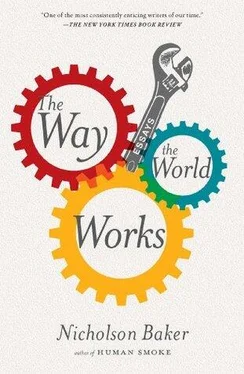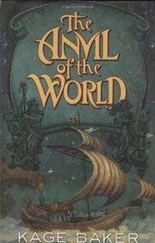Nicholson Baker - The Way the World Works
Здесь есть возможность читать онлайн «Nicholson Baker - The Way the World Works» весь текст электронной книги совершенно бесплатно (целиком полную версию без сокращений). В некоторых случаях можно слушать аудио, скачать через торрент в формате fb2 и присутствует краткое содержание. Год выпуска: 2012, Издательство: Simon & Schuster, Жанр: Публицистика, Критика, на английском языке. Описание произведения, (предисловие) а так же отзывы посетителей доступны на портале библиотеки ЛибКат.
- Название:The Way the World Works
- Автор:
- Издательство:Simon & Schuster
- Жанр:
- Год:2012
- ISBN:нет данных
- Рейтинг книги:4 / 5. Голосов: 1
-
Избранное:Добавить в избранное
- Отзывы:
-
Ваша оценка:
- 80
- 1
- 2
- 3
- 4
- 5
The Way the World Works: краткое содержание, описание и аннотация
Предлагаем к чтению аннотацию, описание, краткое содержание или предисловие (зависит от того, что написал сам автор книги «The Way the World Works»). Если вы не нашли необходимую информацию о книге — напишите в комментариях, мы постараемся отыскать её.
), here assembles his best short pieces from the last fifteen years.
The Way the World Works
OED
Modern Warfare 2
Through all these pieces, many written for
, and
, Baker shines the light of an inexpugnable curiosity.
is a keen-minded, generous-spirited compendium by a modern American master.
The Way the World Works — читать онлайн бесплатно полную книгу (весь текст) целиком
Ниже представлен текст книги, разбитый по страницам. Система сохранения места последней прочитанной страницы, позволяет с удобством читать онлайн бесплатно книгу «The Way the World Works», без необходимости каждый раз заново искать на чём Вы остановились. Поставьте закладку, и сможете в любой момент перейти на страницу, на которой закончили чтение.
Интервал:
Закладка:
Out of that heady period grew Remnick’s first book, Lenin’s Tomb . There’s a characteristic scene early in the book where he is trying to interview the last living member of Stalin’s cabinet — an old man named Kaganovich. Remnick finds out that Kaganovich, by a strange coincidence, lives downstairs from him, and he knocks on the door. He knocks for a long time. There’s no answer. Every day he knocks. He finds Kaganovich’s number and calls it. No answer. He lets it ring for dozens of rings. Finally he reaches Kaganovich’s wife, who says her husband isn’t going to talk. He keeps calling; he wants to see, he says, “what an evil man looked like.” He learns there’s a secret telephone code: let it ring twice, then hang up and call again. Kaganovich answers. Remnick identifies himself. Kaganovich says, “No interviews! That’s it!” He dies soon after. But Remnick had at least heard the voice of the last of Stalin’s inner circle. There are dozens of scenes of poignancy and loss and upheaval in Lenin’s Tomb; it won a Pulitzer Prize in 1994.
By then Remnick was freelancing for Esquire and Vanity Fair, and then staff-writing for Tina Brown’s New Yorker , writing one telling profile after another — on Don DeLillo, on Mike Tyson, on Benjamin Netanyahu. Netanyahu’s father, Remnick wrote, “has little white tufts of hair and weary, narrow eyes, the eyes of a Chinese scholar.” On Tyson’s fight with Evander Holyfield: “Incredibly, Tyson once more nuzzled his way into Holyfield’s sweaty neck, almost tenderly, purposefully, as if he were snuffling for truffles. He found the left ear and bit.” Remnick is modest about these writing successes, which he attributes chiefly to “sitzfleisch”—the capacity to sit in a chair until the work is done. “A lot of what I do is just the mental illness of persistence,” he told me.
In 1998, Remnick published his second book, King of the World, about one of the heroes of his youth, Muhammad Ali. Then something momentous happened: Tina Brown suddenly left her job in order to found a new magazine, Talk . (“Tina is more of a comet than a planet,” said Remnick. “She shines brilliantly and moves from thing to thing.”) S.I. Newhouse, The New Yorker ’s owner, asked David to take over. When the staff heard the news they stood and applauded for five minutes. “It was an applause of relief,” according to Remnick. “It was like the inner applause when you go to the neurologist and you find out that you don’t have a brain tumor.” The job wasn’t easy at first — he lost ten pounds in the first couple of months. It still isn’t easy. “You have to understand,” he said, “for me to be at this magazine is preposterous. I feel like a pretender.”
Actually, though, he’s the real thing: a great, omnivorous editor. He takes The New Yorker ’s history seriously — he’s edited a series of anthologies of themed New Yorker pieces from earlier eras — but he is just as determined that, in the era of iPads and bloggery, he won’t be the last of the magazine’s masters of ceremonies. One of his biggest hits came in 2004: Seymour Hersh’s reporting on abuse in Abu Ghraib. He also brought Ian Frazier, a comic genius, back into the fold — Frazier had been on strike, more or less, during Tina’s tumultuous tenure — and he found and encouraged some good new writers, among them Ben McGrath, who can write deftly about anything, including football concussions and theorists of dystopian collapse.
After 9/11 Remnick had an odd (to me) burst of militancy, as so many did, writing with approval on the attack on Afghanistan, and, in a famous comment piece in “Talk of the Town,” endorsing the invasion of Iraq. “I was wrong,” he told me, about Iraq. He wants his magazine to get truths out. I asked him what he would have done if Julian Assange had offered him a basketful of WikiLeaks documents. Of course he would publish them, he said — he’d let the courts sort it out later. “I think the world is better off knowing than not knowing.”
Last year he published an enormous book about the civil rights movement and the rise of Barack Obama. He wrote it early in the morning, before leaving for work, and late at night. “Sitting next to him, if I hadn’t known he was writing a book, I wouldn’t have been able to tell,” Pam McCarthy told me. “I don’t mean to sound hagiographic, but actually he really is quite amazing. And exhausting.”
Remnick left me in his office while he did an afternoon circle of the twentieth floor. I took some pictures of his bookshelves — hundreds of works by New Yorker contributors past and present, books in Russian, a well-thumbed copy of the poems of Walt Whitman, and a recent run of the magazine bound in black and gold. Then I looked out of the window at a sign that said “Toshiba” in big letters, and another sign for Thomson Reuters. Down the street was the tarnished green roofline of the old New York Times building, one of the seemingly few structures in the neighborhood that was there when the magazine began. I looked at a snapshot of Remnick’s wife and children, at a small plastic windup radio, at a framed photograph of Updike, at another of Ornette Coleman, at hundreds of CDs, and at a nesting doll of Vladimir Putin, whose profile Remnick wrote in 2003. On his desk was “the long”—the single big piece of paper with all the stories on it that were in the hopper, ready to go into future New Yorker s. I felt like a trespasser, like a spy, too high up in the Manhattan skyline for my own good. I heard the discreet bong of a ringing phone. Remnick walked me to the elevators. “Remember what Barbara Walters said at the end of the Jimmy Carter interview?” he asked.
“No,” I said.
“Be kind to us, Mr. President.”
(2011)
Libraries and Newspapers
Truckin’ for the Future
I got a call from the Rochester Public Library, the library I used most as a child. They were getting rid of their card catalog; I had written about card catalogs at some length in The New Yorker . Did I want it? If I paid for shipping, they would mail it from Rochester to Berkeley — minus the cabinets, which had resale value. I said no, I didn’t want it, I wanted them to keep it. So they threw it out.
About a year later, I got some unhappy e-mails from librarians at the San Francisco Public Library. The SFPL had just moved to a new building, and the press was responding with prolonged, ecstatic coverage. Robert Hass, U.S. poet laureate, wrote that “the interior of the library is a marvel, so deeply delicious you forget your previous ideas of what a library is”; Allan Temko, architecture critic for the San Francisco Chronicle, likened its several inner bridges to “the visionary architecture of Piranesi.” The old card catalog, however, was, according to the librarians who wrote me, going to be destroyed — the cards recycled, the cabinets auctioned off. For now it still sat intact in the old building: an ornately carved summation of the contents of a great urban public library, “frozen” (i.e., not filed into or updated) as of 1991. “You are the only one who can save it now,” a librarian wrote me.
Because I felt I had shirked my duty as a preservationist in my hometown, I agreed to try to keep it intact. On May 21, 1996, I made a formal request under the Public Records Act to inspect the card catalog. (The Public Records Act is California’s version of the federal Freedom of Information Act.) This legalistic demarche would, I hoped, define the catalog as a public document, and temporarily prevent the administration from treating it as surplus property. The request was not unreasonable: the database conversion project wasn’t finished, and there were thousands of cards in the card catalog for books held in closed-stack areas of the library that had no match yet in the online system. (More than half the library’s collection was in closed, unbrowsable stacks.) The request was, however, denied, in a letter from the city librarian, Kenneth E. Dowlin: “We are unable to allow this at this time.”
Читать дальшеИнтервал:
Закладка:
Похожие книги на «The Way the World Works»
Представляем Вашему вниманию похожие книги на «The Way the World Works» списком для выбора. Мы отобрали схожую по названию и смыслу литературу в надежде предоставить читателям больше вариантов отыскать новые, интересные, ещё непрочитанные произведения.
Обсуждение, отзывы о книге «The Way the World Works» и просто собственные мнения читателей. Оставьте ваши комментарии, напишите, что Вы думаете о произведении, его смысле или главных героях. Укажите что конкретно понравилось, а что нет, и почему Вы так считаете.












